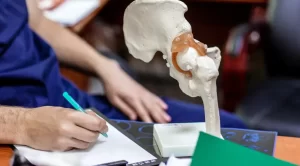In the world of sports, the agility and durability of an athlete’s hip can make or break a career. At The Hip and Pelvis Institute, under the seasoned guidance of Dr. Nicholas H. Mast, we address not just the immediate concerns but also the longitudinal wellness of our athletic patients.
Unlike typical discussions that focus primarily on treatment post-injury, we prioritize a proactive approach—integrating cutting-edge, preventative strategies to maintain hip health before injuries can sideline an athlete. This perspective not only enhances performance but also extends an athlete’s active years, aligning with our commitment to patient-centered, innovative care solutions.
Understanding Hip Injuries in Athletes
The hip joint is a marvel of human anatomy, designed to support the body’s weight while allowing for an impressive range of motion. It is a ball-and-socket joint, with the femoral head fitting snugly into the acetabulum of the pelvis. This structure provides stability and flexibility, essential for athletic performance. However, the complexity of the hip also makes it susceptible to various injuries, especially under the stress of sports activities.
Common Causes of Hip Injuries in Sports
Athletes, particularly those involved in high-impact sports or those requiring repetitive motions, are at significant risk for hip injuries. Sports such as soccer, hockey, running, and gymnastics often see higher incidences of hip-related issues. The main culprits include overuse injuries, improper training techniques, and inadequate conditioning. Overuse injuries arise from repetitive stress without adequate recovery time, leading to conditions like hip flexor strains or labral tears. Improper technique, such as incorrect landing mechanics or poor posture, can place undue stress on the hip joint. Additionally, a lack of strength and flexibility in supporting muscles increases the risk of injuries, as the hip compensates for these deficiencies during athletic activities.
Proactive Hip Health for Athletes
Importance of Warm-Up and Cool-Down Routines
One of the most overlooked aspects of injury prevention is the warm-up and cool-down routine. Engaging in a comprehensive warm-up before athletic activities increases blood flow to the muscles, enhances flexibility, and prepares the hip joint for the demands of sports. Dynamic stretches, such as leg swings and lunges, can effectively prime the hip muscles. Conversely, a proper cool-down routine helps in gradually reducing heart rate and prevents muscle stiffness. Incorporating static stretches post-activity can aid in maintaining flexibility and reducing the risk of injuries.
Strengthening and Flexibility Exercises
Building hip strength and flexibility is paramount for athletes. Targeted exercises such as hip bridges, clamshells, and resisted side steps fortify the muscles surrounding the hip joint, providing better support and stability. Additionally, incorporating flexibility exercises like hip flexor stretches and pigeon poses can improve the range of motion and prevent muscle tightness. These routines should be integrated into the athlete’s regular training regimen to ensure balanced hip health.
Proper Technique and Training
Proper technique is critical in mitigating the risk of hip injuries. Athletes should focus on maintaining correct form during training and competitions to avoid unnecessary stress on the hips. Engaging with professional trainers can help in identifying and correcting any biomechanical flaws. Moreover, personalized training programs that emphasize progressive loading and balanced muscle development can significantly reduce the likelihood of injuries, enabling athletes to perform at their peak while safeguarding their hip health.
Long-Term Hip Health Strategies
Regular Medical Check-Ups and Screenings
Maintaining long-term hip health requires proactive medical oversight. Routine check-ups and screenings can detect early signs of potential hip issues, allowing for timely intervention and preventing more serious injuries. Regular consultations with orthopedic specialists, such as those at The Hip and Pelvis Institute, can help monitor hip health and provide personalized advice.
Balanced Diet and Nutrition
A balanced diet rich in essential nutrients supports overall joint health and resilience. Key nutrients for hip health include:
- Calcium and Vitamin D: Essential for bone density and strength.
- Omega-3 Fatty Acids: Reduce inflammation and support joint health.
- Protein: Supports muscle repair and growth.
- Antioxidants: Protect against cellular damage.
Avoiding Hip Injuries in Sports
Customized Training Programs
Creating customized training programs tailored to the individual needs of athletes is crucial in preventing hip injuries. These programs should focus on:
- Strengthening Core and Hip Muscles: Incorporating exercises that target the core and hip muscles to enhance stability and support.
- Progressive Load Management: Gradually increasing the intensity and volume of training to prevent overuse injuries.
- Balance and Coordination Drills: Integrating balance and coordination exercises to improve proprioception and reduce the risk of falls and missteps.
Importance of Rest and Recovery
Rest and recovery are often underestimated but are essential components of injury prevention. Strategies include:
- Scheduled Rest Days: Ensuring athletes have regular rest days to allow muscles and joints to recover.
- Sleep Hygiene: Promoting good sleep practices to enhance physical recovery and overall performance.
- Active Recovery: Encouraging low-impact activities like swimming or yoga on rest days to maintain mobility without overstraining the hip joints.
Listening to Your Body
Athletes should be attuned to their bodies and recognize early signs of hip discomfort or pain. Key practices include:
- Pain Monitoring: Keeping track of any persistent or unusual hip pain.
- Seeking Early Intervention: Consulting healthcare professionals at the first sign of hip issues to prevent minor problems from becoming major injuries.
- Adjusting Training as Needed: Modifying or scaling back training in response to pain or discomfort to avoid exacerbating potential injuries.
Conclusion
Proactive measures and tailored strategies are key to preventing hip injuries and avoiding surgery, allowing athletes to maintain peak performance and long-term hip health. From proper warm-up routines and strength training to customized training programs and early intervention, these practices help safeguard the hip joints. At The Hip and Pelvis Institute, we are dedicated to providing advanced care and personalized treatment plans. For expert guidance and to ensure your hip health, call us at (415) 530-5330 to schedule an appointment with Dr. Nicholas H. Mast.









